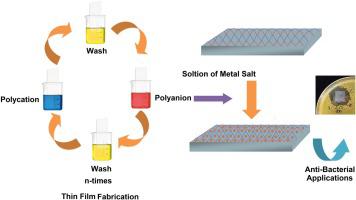当前位置:
X-MOL 学术
›
Colloids Surf. A Physicochem. Eng. Aspects
›
论文详情
Our official English website, www.x-mol.net, welcomes your
feedback! (Note: you will need to create a separate account there.)
Interpenetration of metal cations into polyelectrolyte-multilayer-films via layer-by-layer assembly: Selective antibacterial functionality of cationic guar gum/ polyacrylic acid- Ag+ nanofilm against resistant E. coli
Colloids and Surfaces A: Physicochemical and Engineering Aspects ( IF 4.9 ) Pub Date : 2021-02-01 , DOI: 10.1016/j.colsurfa.2020.125921 Mahmoud H.M.A. Shibraen , Omar M. Ibrahim , Rabie A.M. Asad , Shuguang Yang , M.R. El-Aassar
Colloids and Surfaces A: Physicochemical and Engineering Aspects ( IF 4.9 ) Pub Date : 2021-02-01 , DOI: 10.1016/j.colsurfa.2020.125921 Mahmoud H.M.A. Shibraen , Omar M. Ibrahim , Rabie A.M. Asad , Shuguang Yang , M.R. El-Aassar

|
Abstract There is an urging need for the development of effective coating systems to avoid the rapidly growing resistant bacterial strains on medical devices surfaces that causes nosocomial infections. To this end, we studied the interpenetration of metal ions into polysaccharide thin films. Using several types of polyelectrolyte multilayer (PEM) films constructed from polycations; Quaternized cellulose (QC) and Cationic guar gum (CGG), and poly anions; Carboxymethyl cellulose (CMC) and Polyacrylic acid (PAA), we found that doping of Cu2+, Fe2+ and Ag+ metal ions into PEM matrix occurred through the interactions with polyacids groups. The fabricated thin films were characterized before and after metal interpenetration by FTIR, XRD, SEM, EDX, UV–vis, and optical reflectometry (OR). In comparison to QC/CMC and CGG/CMC thin films, CGG/PAA system exhibited maximum metal loading capacity confirmed by EDX and UV–vis, and 75 % reduction in thickness (215−290 nm) confirmed by OR. Ag+ loaded CGG/PAA nanofilm exhibited a robust antibacterial activity as 50-folds than Fe2+ and 150-folds than Cu2+, against resistant E. coli bacteria via down regulation of erm and β-Lactamase resistance gene expression. Which highlights the efficacy of CGG/PAA-Ag+ as an attractive antibacterial coating material for medical devices.
中文翻译:

通过逐层组装将金属阳离子相互渗透到聚电解质多层膜中:阳离子瓜尔胶/聚丙烯酸-Ag+纳米膜对耐药性大肠杆菌的选择性抗菌功能
摘要迫切需要开发有效的涂层系统,以避免医疗器械表面快速生长的耐药细菌菌株导致医院感染。为此,我们研究了金属离子在多糖薄膜中的相互渗透。使用由聚阳离子构成的多种类型的聚电解质多层 (PEM) 薄膜;季铵化纤维素 (QC) 和阳离子瓜尔胶 (CGG),以及聚阴离子;在羧甲基纤维素 (CMC) 和聚丙烯酸 (PAA) 中,我们发现 Cu2+、Fe2+ 和 Ag+ 金属离子通过与多酸基团的相互作用而掺杂到 PEM 基质中。通过FTIR,XRD,SEM,EDX,UV-vis和光学反射计(OR)在金属互穿前后对制造的薄膜进行表征。与 QC/CMC 和 CGG/CMC 薄膜相比,CGG/PAA 系统表现出由 EDX 和 UV-vis 确认的最大金属负载能力,以及由 OR 确认的厚度(215-290 nm)减少 75%。通过下调 erm 和 β-内酰胺酶抗性基因表达,负载 Ag+ 的 CGG/PAA 纳米膜表现出强大的抗菌活性,比 Fe2+ 高 50 倍,比 Cu2+ 高 150 倍,对抗耐药大肠杆菌。这突出了 CGG/PAA-Ag+ 作为一种有吸引力的医疗器械抗菌涂层材料的功效。
更新日期:2021-02-01
中文翻译:

通过逐层组装将金属阳离子相互渗透到聚电解质多层膜中:阳离子瓜尔胶/聚丙烯酸-Ag+纳米膜对耐药性大肠杆菌的选择性抗菌功能
摘要迫切需要开发有效的涂层系统,以避免医疗器械表面快速生长的耐药细菌菌株导致医院感染。为此,我们研究了金属离子在多糖薄膜中的相互渗透。使用由聚阳离子构成的多种类型的聚电解质多层 (PEM) 薄膜;季铵化纤维素 (QC) 和阳离子瓜尔胶 (CGG),以及聚阴离子;在羧甲基纤维素 (CMC) 和聚丙烯酸 (PAA) 中,我们发现 Cu2+、Fe2+ 和 Ag+ 金属离子通过与多酸基团的相互作用而掺杂到 PEM 基质中。通过FTIR,XRD,SEM,EDX,UV-vis和光学反射计(OR)在金属互穿前后对制造的薄膜进行表征。与 QC/CMC 和 CGG/CMC 薄膜相比,CGG/PAA 系统表现出由 EDX 和 UV-vis 确认的最大金属负载能力,以及由 OR 确认的厚度(215-290 nm)减少 75%。通过下调 erm 和 β-内酰胺酶抗性基因表达,负载 Ag+ 的 CGG/PAA 纳米膜表现出强大的抗菌活性,比 Fe2+ 高 50 倍,比 Cu2+ 高 150 倍,对抗耐药大肠杆菌。这突出了 CGG/PAA-Ag+ 作为一种有吸引力的医疗器械抗菌涂层材料的功效。










































 京公网安备 11010802027423号
京公网安备 11010802027423号